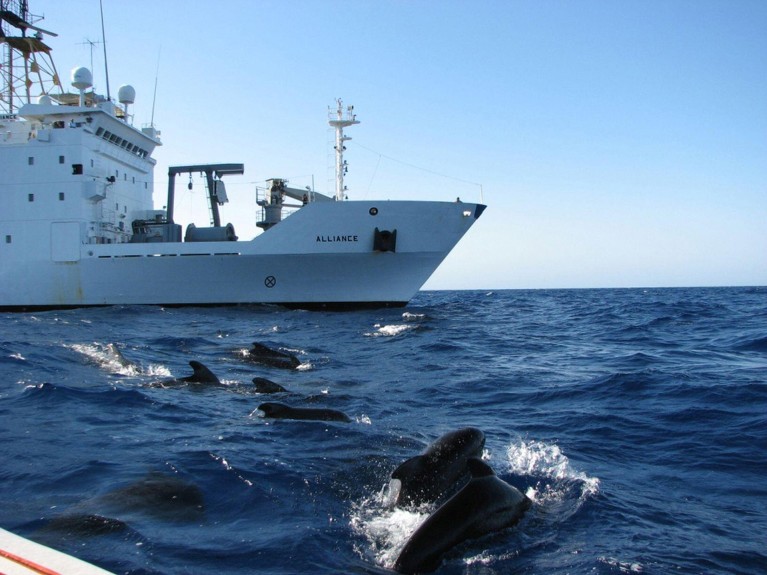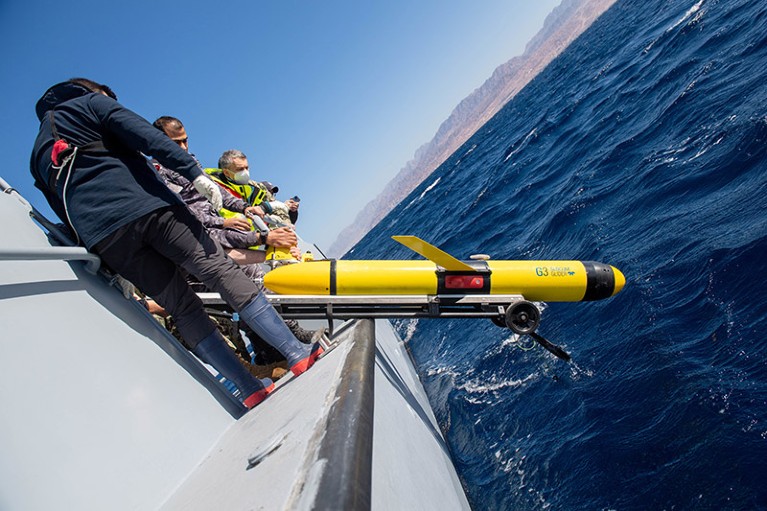
A NATO analysis vessel conducting research of marine mammals within the Mediterranean Sea (pictured in 2009).Credit score: U.S. Navy Petty Officer 2nd Class Kristen Allen by way of Mil picture/Alamy
Science has been important to the North Atlantic Treaty Group (NATO), the political and army alliance based 75 years in the past this month. The 32-country alliance is admitting extra members because it faces evolving geopolitical and army threats. The group’s scientific work focuses largely on defence and civil-security initiatives that, for example, examine how local weather change is affecting battle, how rising applied sciences might improve troopers’ efficiency and how one can scale back discrimination and intolerance amongst army personnel. “The position of science and know-how for NATO is prone to develop considerably over the following twenty years,” predicts Simona Soare, a defence-technologies researcher at Lancaster College, UK.
How does NATO use science?
“We’re trying to ensure that we are able to present scientific recommendation to the nations of NATO to allow them to take care of a technical and army benefit,” says Bryan Wells, a chemist and the group’s chief scientist. Wells works at NATO’s Brussels headquarters, the place world leaders gathered earlier this month to mark the group’s seventy fifth anniversary.
NATO has a fancy organizational construction together with each army and civilian workers. The civilian a part of NATO is headed by a senior political determine from a member state and likewise contains diplomats representing member international locations. The army half is headed by senior army personnel.
A lot of NATO’s analysis and growth (R&D) takes place by way of the Science and Know-how Group (STO), a community of greater than 6,000 scientists at universities and nationwide laboratories and in trade. They work collectively on defence analysis initiatives. NATO’s member states and non-member international locations collectively contribute round €350 million (US$380 million) yearly for the work of this community, says Wells.
The STO additionally has its personal analysis laboratory, the Centre for Maritime Analysis and Experimentation (CMRE) in La Spezia, Italy. The laboratory employs round 150 folks and is led by Eric Pouliquen, a physicist who has labored on underwater distant sensing.
NATO’s civilian arm supplies grants for a Science for Peace and Safety (SPS) analysis programme, headed by Claudio Palestini, a researcher in communications engineering.
The programme funds research in areas equivalent to counterterrorism and cyber defence. Earlier this month, the SPS programme up to date its priorities. These now embody research on the affect on defence and safety from local weather change and from AI; defending underwater infrastructure, and what it calls “hybrid threats”, which incorporates interference in elections and disinformation. Every of its bigger grants is value between €250,000 and €400,000 and lasts for 2 to a few years.
Wells says the STO publishes analysis — principally from the CMRE — in peer-reviewed journals the place doable. “We acknowledge if we are able to publish overtly, it’s very helpful to do this,” he says.
Nevertheless, lots of its analysis initiatives are categorised. NATO additionally doesn’t publish an in depth breakdown of its R&D earnings and expenditure by nation; nor does it launch its funding development information.
What kind of analysis is NATO doing?
Initiatives cowl a spectrum of fields together with utilizing autonomous undersea surveillance to hunt for and establish mines; monitoring and figuring out submarines; quantum radar; and artificial biology.
For instance, one programme led by CMRE researchers explores how autonomous underwater automobiles can establish submarines utilizing quantum applied sciences and synthetic intelligence. Equally, one other mission, ‘Army Variety in Multinational Defence Environments: From Ethnic Intolerance to Inclusion’ studied the explanations for intolerance inside NATO members’ armed forces as a part of an total technique to enhance range and inclusion throughout the group..
NATO is inspecting how AI might have an effect on troops’ capability to hide themselves and evade detection. One other initiative is investigating how biotechnology might enhance troopers’ efficiency by enhancing the microbiome or by way of brain-computer interface applied sciences.
Why is NATO focused on local weather analysis?
NATO is anxious that climate change has important impacts on safety. Melting sea ice creates extra routes for naval transport within the Arctic, for instance, and NATO and non-NATO international locations are more and more working within the area.
NATO can also be focused on how temperature adjustments might have an effect on the safety of its member and non-member international locations in addition to of army installations around the globe. In a 2024 evaluate paper within the Texas Nationwide Safety Evaluation, CMRE researchers — together with colleagues from the College of St Andrews, UK, the College of L’Aquila, Italy, and the Swiss Federal Institute of Know-how in Zurich — discovered that submarines might grow to be tougher to detect utilizing sonar within the North Atlantic Ocean as water temperature rises.
In one other research, offered ultimately week’s convention of the European Geosciences Union in Vienna , CMRE researchers working with scientists on the universities of Princeton in New Jersey and Central Florida in Orlando assessed how excessive climate may have an effect on 91 NATO army bases and installations. The researchers discovered that a number of bases and installations are prone to grow to be inclined to local weather change as emissions proceed to rise.
In one other mission, final 12 months considered one of NATO’s analysis vessels moored vertical traces holding oceanographic and acoustic recorders within the Arctic Ocean. The intention was to observe temperature, salinity and ambient noise all through the water column. Different analysis initiatives are using new supplies for army clothes in hotter climates, says Wells.
In 2022, NATO additionally printed the primary of a sequence referred to as Local weather change and Safety Impression Evaluation. Additionally it is growing a strategy to map greenhouse-gas emissions from NATO-member army actions and installations.

Personnel from NATO and the Royal Jordanian Navy decrease an unmanned undersea automobile into the Gulf of Aqaba (pictured in 2022).Credit score: U.S. Navy photograph by Mass Communication Specialist 2nd Class Dawson Roth
How has NATO’s enlargement affected science?
NATO’s membership has greater than doubled since its founding on 4 April 1949. Finland and Sweden are the most recent international locations to affix. Three extra — Bosnia and Herzegovina, Georgia and Ukraine — wish to grow to be members.
Extra members doubtlessly means extra funding and assist for analysis and growth, in addition to entry to a much bigger pool of scientific experience. Nevertheless, Finland and Sweden each participated in NATO’s collaborative analysis for a number of years earlier than they joined, says Wells.
Soare says that NATO’s defence science initially targeted on aerospace, to assist its members catch up after the Soviet Union launched Earth’s first synthetic satellites — Sputnik 1 and Sputnik 2 — in 1957. “All through the chilly battle, guaranteeing air superiority was thought-about essential,” she says.
What a couple of position for science in diplomacy?
In 1958, NATO established analysis fellowships and initiatives in what later turned its Science for Peace and Safety programme, to spice up collaboration between nations together with the US and the Soviet Union. “Science supplied a path for superpower adversaries to cooperate,” says Paul Arthur Berkman, founding father of the Science Diplomacy Middle in Falmouth, Massachusetts.
The fellowships and collaborative initiatives continued to offer a degree of contact between NATO and Russia till 2014, when Russia invaded Crimea. That 12 months, Russia, Romania and the US have been collectively growing a system to attach telemedicine capabilities throughout all three international locations to offer medical care in distant and emergency conditions. Nevertheless, the invasion prompted NATO to freeze cooperation with Russia.
Berkman, who in 2010 co-organized and chaired the primary dialogue between NATO and Russia relating to environmental safety within the Arctic, is anxious on the alliance’s shift away from utilizing science as a “security valve” in its relations with Russia. He warns that slicing off scientific dialogue with Russia undermines democracy and nations’ capability to deal with world challenges equivalent to local weather change.
“Open science is akin to freedom of speech. If we flip off open science, in a way we’re undermining democracy,” says Berkman.